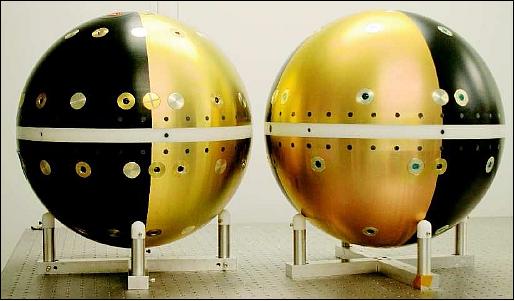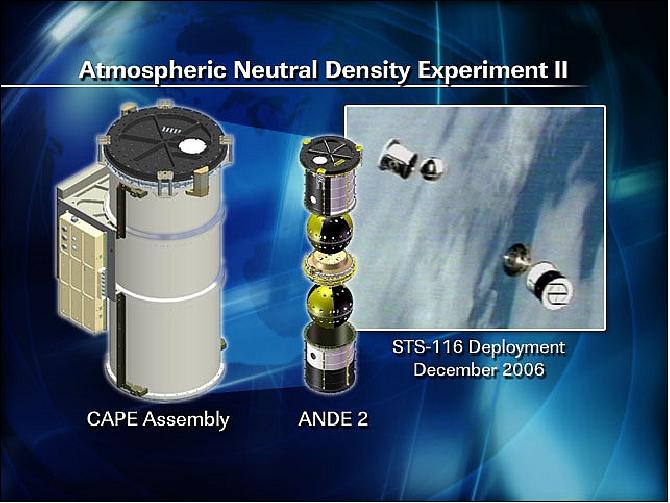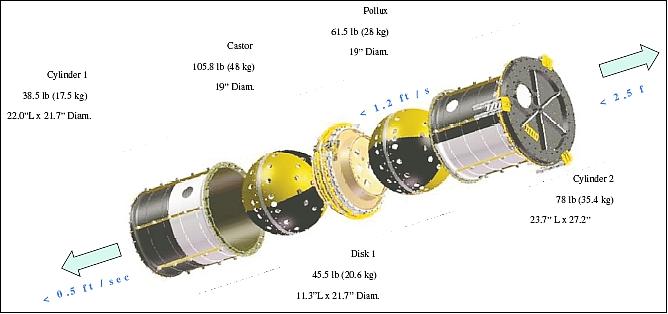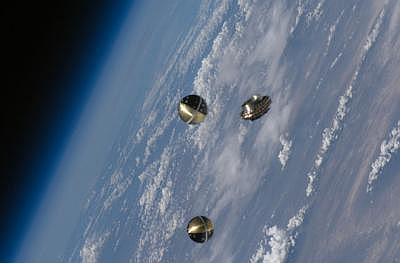ANDE-2 (Atmospheric Neutral Density Experiment-2)
EO
Atmospheric Temperature Fields
Mission complete
Atmospheric Winds
Quick facts
Overview
| Mission type | EO |
| Agency | NRL |
| Mission status | Mission complete |
| Launch date | 30 Jul 2009 |
| End of life date | 18 Aug 2010 |
| Measurement category | Atmospheric Temperature Fields, Atmospheric Winds |
| Instruments | GPS receiver |
| Instrument type | Atmospheric temperature and humidity sounders |
| CEOS EO Handbook | See ANDE-2 (Atmospheric Neutral Density Experiment-2) summary |
ANDE-2 (Atmospheric Neutral Density Experiment-2)
The ANDE-2 is a follow-up mission of ANDE (launch on STS-116 to ISS on Dec. 16, 2006 ) and a low-cost mission of NRL (Naval Research Laboratory) to demonstrate a method to monitor the thermospheric neutral density from an initial altitude of about 350 km downwards. The overall objective is to provide high-quality for satellites calibrating techniques and to improve the drag coefficient models for precision orbit determination.
The ANDE-2 satellite suite consists of two nearly perfectly spherical microsatellites with instrumentation to perform two interrelated mission objectives. The first objective is to monitor the total atmospheric density along the orbit for improved orbit determination of resident space objects. The second is to provide a test object for both radar and optical U.S. Space Surveillance Network sensors. 1) 2)
Spacecraft
The two microsatellites are fitted with retroreflectors for tracking by the ILRS (International Laser Ranging Service) network as well as the SSN ( Space Surveillance Network). The active spacecraft is named Castor while the passive spacecraft is named Pollux. The two spheres were custom designed by the Naval Center for Space Technology and with implementation and fabrication by the NRL Space Sciences Division.. 3)
The satellites are identical in dimension (diameter of 48.26 cm, or 19 inch), but have different masses. Each spacecraft is fitted with a set of 30 optical retro reflectors (each of 12.7 mm diameter) for SLR (Satellite Laser Ranging), located along latitude bands at ± 90º, ± 52.5º, and ± 15º with one, six and eight retroreflectors per band, respectively.

Parameter | Castor (active microsatellite) | Pollux (passive microsatellite) |
Expected life in orbit | 1.5 year | 1 year |
Primary applications | Determine total atmospheric density in the orbital plane | |
Primary SLR applications | Precision orbit determination | |
RRA (Retroreflector Assembly) | 12.7 mm diameter | |
Diameter of sphere | 48.26 cm | 48.26 cm |
Mass of sphere in orbit | 47.45 kg | 27.442 kg |
Difference between mass center and geometric center | 6.35 mm radius | 5.0 mm radius |
Orbit at deployment | Altitude: ~350 km | |
ANDE-2 deployment date | July 30, 2009 at 19:19:52 UTC 4) | |
Launch
The ANDE-2 payload was launched on the Space Shuttle flight STS-127 Endeavour (July 15 -31, 2009, 16 day mission). The STP (Space Test Program) of DoD provided the launch services for the ANDE-2 mission. 5) 6) 7)
Spacecraft
The ANDE-2 microsatellites were ejected from the Shuttle Bay of Endeavour on July 30, 2009 at 19:19:52 UTC after undocking from the ISS. 8)
ANDE-2 used the CAPE (Canister for All Payload Ejections) ejection system, the same system as demonstrated for ANDE on STS-116 on Dec. 10, 2006. CAPE is a cylinder tube, an envelope of 53 cm in diameter and 135 cm in length, that holds the ICU (Internal Cargo Unit) for the two microsatellites. The ICU is a payload interface mechanism that serves as the unique payload carrier, totally enveloping the payload. The ICU-to-CAPE interface is the primary separation system for ejecting the ICU from the CAPE canister. The entire volume can be used to hold a payload, without affecting the ejection parameters of the CAPE system.
The ICU allows both microsatellites to be ejected from the Orbiter at the same time while having no traditional mechanical interface to the spheres. The ICU is a three segment device consisting of bottom, middle and top sections. The sections are held together by two secondary separation systems, also LightbandTM separation devices.


Sensor Complement
Each satellite contains a small lightweight payload designed to determine the spin rate and orientation of the satellite from on-orbit measurements and from ground-based observations. The two microsatellites will slowly separate into a lead-trail orbit to provide researchers an opportunity to study small-scale, spatial and temporal variations in drag associated with geomagnetic activity.
The orbit of both satellites will be observed by the U.S. Space Surveillance Network and domestic and international satellite laser ranging sites. The variation in observed position will be used to determine the in-track total density.
Castor
The Castor microsatellite carries active instruments: a miniature wind and temperature spectrometer to measure atmospheric composition, cross-track winds and neutral temperature; a GPS (Global Positioning System) receiver; a thermal monitoring system to monitor the temperature of the satellite; an electrostatic analyzer to monitor the plasma density of spacecraft charging.
In addition, a group of college students designed and built a MEMS sensor payload to test some commercial gyroscopes and a magnetometer.
The equator plane of Castor is constructed from an engineered polymer material (Delrin) which provides a non-conductive separator between the hemispheres. This allows the satellite's shell to perform as a dipole antenna for the communications system developed at the USNA. The communications system is powered by several battery boxes, which gives the satellite an estimated lifetime of about 1.5 years. The payload is split into the two hemispheres, with two battery banks, a communications box, and the laser driver box stacked in a vertical configuration.
Castor is powered by 112 Li-ion cells (each of 19 Ah capacity) configured to provide 14 V. The battery capacity is ~ 7000 Whr to sustain operations for about a year (Ref. 5).
The RF communications system features the AX.25 and FX.25 packet services. The primary system provides telemetry in VHF at a frequency of 145.825 MHz.
Pollux
The Pollux satellite was originally to be a passive satellite with retroreflectors for laser ranging. It has been turned into a high school student project involving several schools in the Fairfax County, Virginia area. The microsatellite is powered by 28 Li-ion cells (each of 19 Ah capacity) configured to provide 14 V. The battery configuration uses the spare ANDE satellite hardware.
The RF communications board contains the transmitter and receiver. The transmitter operates at VHF with an output signal of up to 1 W (frequency of 145.825 MHz). The power level is adjustable. The transmitter can operate at 1200 baud AFSK and 9600 baud FSK. The transmitter uses the AX.25 protocol. In addition, an experimental FX.25 protocol will be tested that adds forward error correction capability to the AX.25 protocol and still allows typical TNCs to decode the packets.

Legend to Figure 4: The avionics deck of the ICU is also visible on the right side of the photograph, taken by the crew of STS-127 from the flight deck.
Mission Status
• The last observation of the passive sphere, ANDE Pollux with a mass of 27.44 kg, was on March 28, 2010 at 22:55 from the Beale Phased Array (west coast of CONUS); shortly thereafter, the spacecraft re-entered the Earth's atmosphere. 9)
• The active sphere, ANDE Castor with a mass of 47.45 kg, re-entered the Earth's atmosphere on the 18th August, 2010. 10) 11)
References
1) “ANDE (Castor and Pollux),” URL: http://ilrs.gsfc.nasa.gov/satellite_missions/list_of_satellites/andp_general.html#instrument
2) L. Thomas, “ANDE Concept,” 16th International Workshop on Laser Ranging, Poznan Poland, October 2008.URL: http://cddis.gsfc.nasa.gov/lw16/docs/presentations/ops_14_Thomas.pdf
3) Andrew C. Nicholas, Ted Fine, Mark A. Davis, Robert Kessel, “Atmospheric Neutral Density Experiment (ANDE-2) Flight Hardware Details,” May 26, 2009, URL: http://ilrs.gsfc.nasa.gov/docs/andehw.pdf
4) “ANDE-2 Deployed from Space Shuttle Endeavour,” NRL, URL: http://www.nrl.navy.mil/pao/pressRelease.php?Y=2009&R=84-09r
5) Donna McKinney, “Navy's ANDE-2 Launched Aboard Endeavour Downlink on 2 Meters,” July 18, 2009, URL: http://mt-milcom.blogspot.com/2009/07/navys-ande-2-launched-aboard-endeavour.html
6) “Navy's ANDE-2 Launched Aboard Space Shuttle Endeavour,” July 17, 2009, URL: http://www.navy.mil/search/display.asp?story_id=47021
7) “Naval Research Laboratory's ANDE-2 launched aboard Space Shuttle Endeavour,” July 17, 2009, URL: http://www.sciencecodex.com/naval_research_laboratorys_ande2_...
8) STS-127 Space Shuttle Endeavour ANDE-2 satellite Deployment 07/30/09,” URL: http://www.youtube.com/watch?v=EqVwDt0PVMM
9) http://ilrs.gsfc.nasa.gov/satellite_missions/list_of_satellites/andp_general.html
10) http://reentrynews.aero.org/2009038f.html
11) http://astronomy.activeboard.com/forum.spark?aBID=58381&topicID=37399733&p=3
The information compiled and edited in this article was provided by Herbert J. Kramer from his documentation of: ”Observation of the Earth and Its Environment: Survey of Missions and Sensors” (Springer Verlag) as well as many other sources after the publication of the 4th edition in 2002. - Comments and corrections to this article are always welcome for further updates (eoportal@symbios.space).